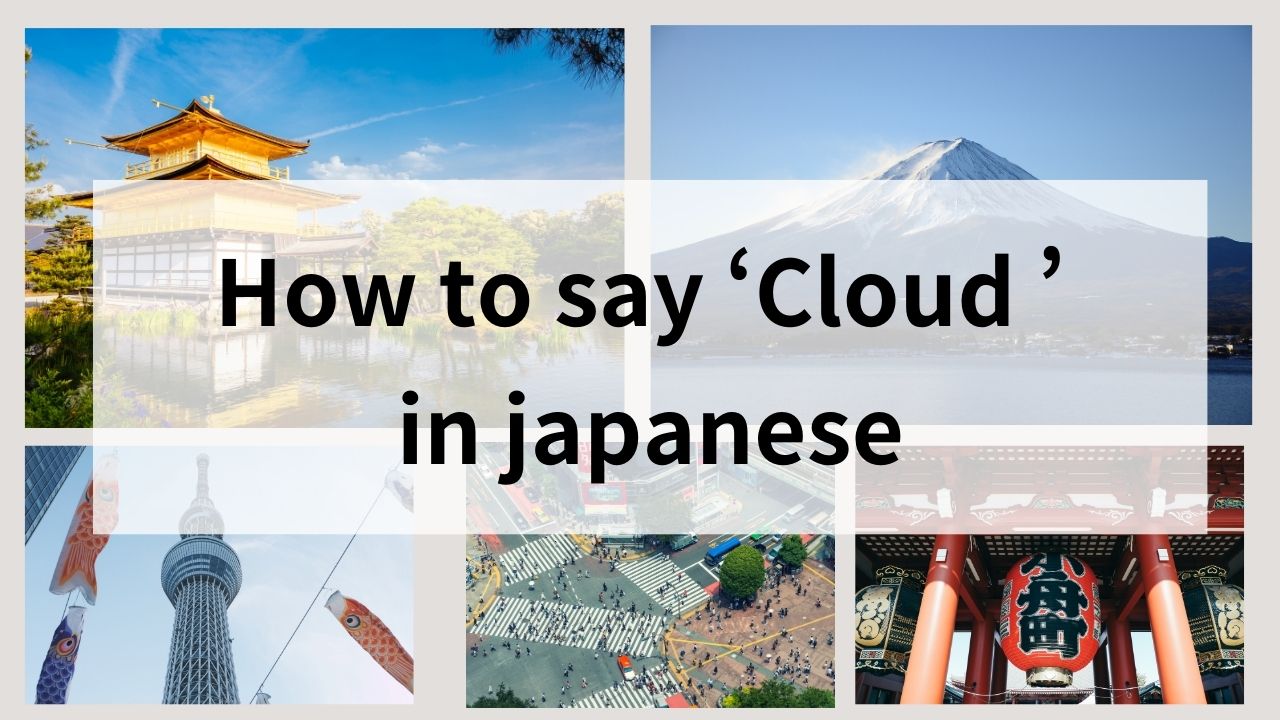Are you curious about how to say “cloud” in Japanese? The concept of clouds carries various cultural meanings and associations in Japan, from aesthetics to spirituality. This guide will explore the Japanese word for “cloud,” its cultural significance, and practical applications.
How Do You Say “Cloud” in Japanese?
The Japanese word for “cloud” is 雲 (kumo). This term is widely recognized and used in both casual and formal contexts. Clouds have a rich history in Japan, often associated with nature, change, and even spirituality.
The Japanese Word for Cloud: Kumo (雲)
“Kumo” is a term used to describe clouds and appears in various phrases and contexts. For example:
- 雲がある (Kumo ga aru): “There are clouds.”
- 雲の上 (Kumo no ue): “Above the clouds.”
- 青空と雲 (Aozora to kumo): “Blue sky and clouds.”
Kanji for Cloud: 雲
The kanji for cloud, 雲, is commonly used in literature, traditional contexts, and everyday language. This visually striking character reflects the ethereal and transient nature of clouds. The primary reading for this kanji is くも (Kumo), but it can also have a different reading in compound words.
Examples of words containing the kanji 雲 include:
- 雨雲 (Amagumo): “Rain cloud.”
- 白雲 (Hakugumo): “White cloud,” which is often associated with beautiful weather.
- 雲海 (Unkai): “Sea of clouds,” a breathtaking natural phenomenon often viewed from mountains.
This kanji is associated with various weather phenomena and reflects the beauty and transience of clouds in Japanese culture. Recognizing these patterns can help learners understand the nuanced use of 雲 in Japanese.
Does “Cloud” Work in Japanese?
The English word “cloud” is generally understood in Japan, particularly among younger generations or those familiar with technology and modern culture. However, its recognition might be less universal among older individuals or in more traditional contexts. A 5-point scale rates its comprehension as:
- Rating: 4 – Generally understood (60-80% of people)
If clarity is crucial, using the Japanese term くも (Kumo) is recommended. While “cloud” may be understood in certain contexts, “kumo” ensures effective communication.
The Cultural Significance of Clouds in Japan
Clouds have held a special place in Japanese culture for centuries, symbolizing change, impermanence, and the transient beauty of life. They are often depicted in art and literature, conveying a sense of mystery and depth.
Clouds as Symbols of Transience
In Japanese aesthetics, especially in the philosophy of “mono no aware,” clouds represent the fleeting nature of beauty and existence. The shifting shapes and colors of clouds are often seen as reflections of life’s impermanence.
Clouds in Japanese Folklore and Mythology
Clouds appear in various Japanese myths and stories, often symbolizing the presence of gods or the passage between worlds. They are sometimes linked to rain, which is considered a blessing in Japanese culture, enhancing their significance.
In addition to traditional associations, clouds play a notable role in modern Japanese pop culture. This connection emphasizes the visual and emotional impact of clouds in storytelling and art.
- Spirited Away: The film features stunning cloudscapes that symbolize the journey between the human and spirit worlds.
- Nausicaä of the Valley of the Wind: Clouds are depicted as both beautiful and ominous, reflecting the film’s themes of environmentalism and change.
- My Neighbor Totoro: The fluffy clouds in this film evoke a sense of innocence and wonder, enhancing the magical atmosphere.
- Weathering with You: This film deeply explores the relationship between weather, emotions, and the power of clouds in shaping human experiences.
- Attack on Titan: The ominous clouds often foreshadow danger and the unpredictable nature of the world.
These examples demonstrate how clouds continue to represent mystery, change, and the connection between the earthly and divine, bridging traditional folklore and modern storytelling.
Differences Between Clouds in Japan and Overseas
There can be subtle differences in how “cloud” is perceived in Japan versus Western cultures. In Japan, “kumo” (雲) often refers to a more poetic and aesthetic interpretation of clouds, associated with beauty and transience. Meanwhile, in Western contexts, “cloud” may also include technical meanings related to technology (such as cloud computing) and weather forecasting. Understanding these cultural nuances can help avoid confusion, especially when discussing weather or metaphorical concepts in creative or professional settings.
Practical Applications of “Cloud” in Japanese
Learning how “cloud” is used in Japanese can help you navigate conversations, understand idioms, and recognize its presence in Japanese culture.
Talking About Clouds in Daily Conversation
Here are some examples of how “kumo” is used in everyday conversation:
- 雲が多いですね (Kumo ga ooi desu ne): “There are many clouds, aren’t there?”
- 雲の形が面白い (Kumo no katachi ga omoshiroi): “The shape of the clouds is interesting.”
Cloud-Related Idioms or Expressions
While there are relatively few specific idioms involving “kumo,” clouds are often associated with change, beauty, and the passage of time in Japanese culture. Here are some idioms, phrases, and expressions that incorporate or symbolize clouds:
- 雲の上の生活 (Kumo no ue no seikatsu): “Life above the clouds,” symbolizing a carefree or idyllic life.
- 雲が切れる (Kumo ga kireru): Literally “the clouds part,” meaning that difficulties are resolved or that a ray of hope appears.
- 雲隠れ (Kumogakure): “Cloud hiding,” referring to someone who is elusive or hard to find.
- 雲を掴むような (Kumo o tsukamu you na): Literally “like grasping at clouds,” meaning something is unattainable.
- 雲海に浮かぶ (Unkai ni ukabu): “Floating on a sea of clouds,” used metaphorically to describe a feeling of bliss or peace.
These idioms and expressions reflect the deep cultural appreciation of clouds in Japan, often tied to themes of beauty, change, and spirituality. By learning these phrases, you can gain a deeper understanding of how clouds are interwoven with Japanese language and values.
Clouds in Japanese Cuisine or Products
Clouds also find their way into Japanese cuisine and products, showcasing their aesthetic appeal and cultural significance. Here are some notable examples:
- Cloud Cakes (雲のケーキ, Kumo no kēki): A light and fluffy cake often made with egg whites, resembling the softness of clouds.
- Cloudy Sake (雲の日本酒, Kumo no nihonshu): A type of sake that appears cloudy, reflecting the traditional brewing process.
- Cloud-shaped Mochi (雲の形の餅, Kumo no katachi no mochi): A popular sweets shaped like clouds, often enjoyed during festivals.
These examples highlight how clouds not only contribute to the visual appeal of food but also enhance the cultural experience of Japanese cuisine.
FAQs
Here are some frequently asked questions about clouds in Japanese culture and language.
Is Cloud a Popular Concept in Japan?
Yes, clouds are a popular concept in Japan, often associated with beauty, change, and the transient nature of life. They are frequently depicted in art, literature, and festivals.
How Do You Write “Cloud” in Japanese?
The word “cloud” can be written in three different scripts in Japanese: hiragana, katakana, and kanji. Each script serves different purposes depending on the context and formality. Here’s a breakdown:
- Hiragana (くも, Kumo):
Hiragana is the most commonly used script for “cloud” in casual writing or when teaching children. It is simple and easy to read, making it ideal for everyday use. - Katakana (クモ, Kumo):
Katakana is rarely used for “cloud,” but it may appear in stylistic contexts, such as advertisements, product names, or when emphasizing the word in text. - Kanji (雲, Kumo):
Kanji is the most formal and traditional way to write “cloud.” It is often used in literature, official documents, and cultural contexts. The kanji itself conveys a sense of elegance and depth.
Choosing which script to use depends on the tone, audience, and purpose of your communication. Understanding these variations can enhance both your written and spoken Japanese skills.
Conclusion
Cloud, or “kumo” in Japanese, is more than just a weather phenomenon—it symbolizes beauty, change, and cultural significance. By understanding its role in Japanese language and traditions, you can deepen your appreciation for clouds and their place in Japanese society.








